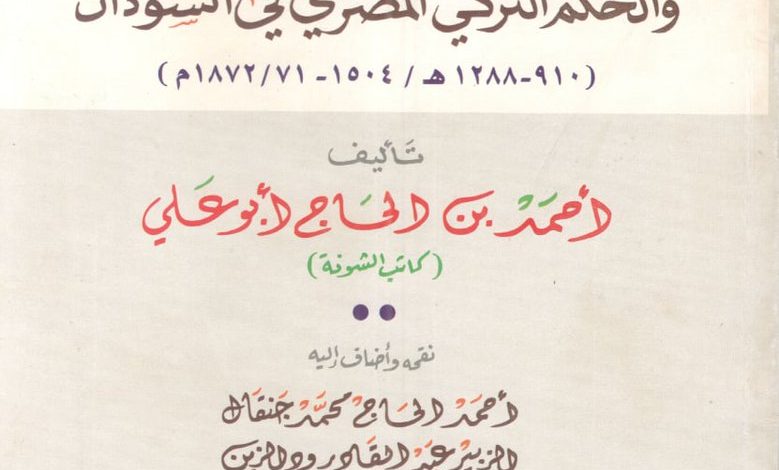Book Review – Pondering into Shona’s Book Manuscript

Mohammed El-Sheikh Hussein
abusamira85@gmail.com
Professor / Youif Hassan Fadl, in his new investigation of Shona’s Book Manuscript, settled the controversy that has been raging since the beginning of the last century about who wrote the manuscript by confirming that Shona’s Book Manuscript was produced in its final form by five writers who had attained a good degree of religious knowledge.
All copies
The reason for this introduction is that Professor Yousif has completed a scientific investigation of the manuscript of Shona’s Book, in which he relied on ten different copies found in the libraries of: the National Archives, the archives of Sherif Yousif Al-Hindi, Cairo, Istanbul, Paris, the British Museum, the School of Oriental and African Studies in London, and the University of Oxford, Vienna, Bassano, and Nottingham, which are the oldest of these copies and the closest to the original in which the manuscript was issued.
Without any attempt to show humility, Professor Yousif has accomplished an important work in chronicling Sudanese history. It took about 25 years to prepare it with individual and very personal efforts, as he began it in the year 1992, so that the book’s investigation came out of the printing press in August 2018.
The importance of this investigation lies in the fact that the history of writing the history of Sudan is a very recent matter, and may be incomplete. It also seems repetitive and is characterized by the abundance of what history neglected intentionally, inadvertently, or by conspiracy, in addition to the abundance of what people turned a blind eye about. Perhaps the completion of this investigation fill in a gap in the authentic Sudanese historical heritage.
Semantic Elements
The investigated text of Professor Yousif Fadl provides its reader with various cultural sources in its semantic and historical elements. Professor Yousif came to the art of investigation from an original specialty in history and different new methods in what was recently known as Sudanese studies. Thus, he came to the manuscript of the author of Shuna, amplified by experience, the experience of the researcher when he scrutinizes the text to illuminate it, and perhaps he does so while listening closely to the rhythm of life and the stories of things around him. We may not be exaggerating if we say that we can read, through Professor Yousif’s books, research, and papers, something of Sudan’s biography and the stages of life development that it went through. His research reveals his personality and reveals a natural love that reveals some pictures of Sudanese life and its national and legendary symbols.
An existential state
It is known that editing manuscripts is a science and an art, but according to Professor Yusuf, it does not have a known place where it ends, as Ibn Arabi put it. If we recall the mystics of Sufis, this investigation is a movement that never stops. Perhaps Professor Yousif, in editing the manuscript of Shona’s Writer, represents Ibn Arabi’s saying: (And if a stage appears to you in which you say, ‘This is my goal,’ another path opens up for you from which you gain provision and leave. There is no stage you can reach without saying, ‘This is my goal.’ Then, when you reach it, you will soon leave it off). This type of investigation appears clearly in the investigation, as it dealt with the copy of the Shona’s writer, Ahmed Bin Al-Hajj Abu Ali, and the four writers who revised it and added to it.
New language
The one who meditates on the manuscript of Shona’s Writer notices the birth of a new language that amazes you with its science-based, as it intends to combine vocabulary that went extremely deep in Sudanese dialect, and other vocabulary that is deep in its modernity. This is why the investigation, according to Professor Yousif, was two intertwined and interwoven movements: a movement of retrieval, which is a movement of memory that keeps returning to the past, picking up its fragments and seeking to reassemble them again, and a movement of anticipation, which is a movement that heads to the future, that is, to the dream, seeking to spell its language and decipher its symbols. There is no surprise in this, as it is of course not possible for someone to chronicle the scene of writing the history of Sudan without pausing carefully at the name of Professor Yousif, and his pioneering role in shaping the Sudanese school in writing the country’s history.
Important point
An important point is that Professor Yousif knew how to distance his scientific project from ideological confinement, narrow fanaticism, and the personal project, to transform it with clear influence from scientific research into an open platform for cultural debate in his enlightenment project. He realized, from an early age, the importance of examining manuscripts in their various versions and establishing distinctive relationships with eyewitnesses, narrators, sheikhs and descendants who played prominent roles in the country’s history.
It seems to me that Professor Yousif, when he ventured more than 45 years ago to write the book (Tabagat Wad Dhaif Allah), established the era of maturity of national interest in Sudanese manuscripts in their various collections and different times, based on the fact that knowing the ancestral past and its cultural content is a starting point for the future.
Shona’s writer
El-Sheikh Ahmed Bin Al-Hajj Abu Ali, known as (Shona’s Writer), is considered as one of the first historians in Sudan, and his book entitled (The History of the Kings of Sinnar and Turkish-Egyptian Rule in Sudan – 910-1288 AH / 1504-71/1872 AD) is considered as the most important Sudanese reference book in modern history.
The Shona’s writer was born in Goz Al-Muslimiya, between the cities of Medani and Hassahisa, in the year 1785. He joined the service of the Egyptian administration as a clerk in the feed storage in Khartoum between 1824 and 1834 AD, and finished writing his book in 1838 AD.
The author of Shona, in compiling his book, generally followed the method of Arab historians and narrated the conditions according to their occurrence year by year, covering the history of the Sultanate of Sinnar from its establishment until after the Turkish-Egyptian era.
Abandoned manuscript
The book remained a neglected manuscript for a long time, and was known by more than one title in its various copies spread inside and outside Sudan. The book became known as Shona’s Book Manuscript, named after the job of its first author, and Professor Yousif chose the title (The History of the Kings of Sinnar and Turkish-Egyptian Rule in Sudan). The introduction to the investigation reveals that the best thing that informs us about the manuscript and describes its content is the letter sent by the Governor of Sudan, Gordon Pasha, to the Khedive of Egypt, accompanied by a copy of this book, which reads (From the Governorate to the “Subsidiary”, dated 3 Ramadan, 1295 AH (1878 AD). In this batch, such an author’s copy was obtained. By stating the names of the former rulers and kings of Sudan and the date of the accession and abandonment of the position of king of each of them, and so on until the Khedival government took over these lands.
The importance of the manuscript
The importance of Shona’s Book manuscript became apparent when Colonel Stewart relied on it in a historical introduction to his report to the British government on the situation of Sudan at the dawn of the Mahdist revolution. Noam Shugair benefited from it in his book (Geography and History of Sudan), which is the main, according to Professor Yousif’s description of it. The English historian Budge and Lees relied on it, not in his book (The Egyptian History of Sudan). It was an important source for Jackson in his book (The Tooth of Fire). Mac-Michael used it in his books (The Tribes of North and Central Kordufan) and (The History of the Arabs in Sudan). The importance of the manuscript prompted Mac-Michael to translate it into 48 pages and comment on it extensively in 25 pages, which was the first attempt to verify the manuscript. The second attempt to verify the manuscript came from Professor Makki Shebika, who published it in 1947.
The manuscript as a whole
In general, the Shona’s Book Manuscript dates the Zarqaa Sultanate from its establishment in 1504 until its fall in 1821 AD, then extending to the year 1871. The manuscript detailed the last years of the Sultanate’s life, beginning with the reign of Sultan Badai IV. It went through four traditional historians and was subjected to revision. It is a source connected to the biography of its author, Ahmed Bin, known as (Shona’s Book). The four historians who received the manuscript and who revised it and added to it in the order of Professor Yousif are: Ahmed Mohamed Janal, Al-Zubair Abdul Gadir Wad Al-Zein, who is known as (Wad Dawa), Ibrahim Abdul Dafi, and Al-Amin Mohamed Al-Darir. There is a copy of this manuscript in the British Museum, and it is one of the copies produced by Professor Mekki Shebika in 1947 under the title (The History of the Kings of Sudan).
Copies of the manuscript
There are several copies Shona’s Book Manuscript. There is a copy in the Egyptian Library, and it is a photocopy of the copy of the National Library in Paris. This version was verified by the brilliant Egyptian historian Busaili Abdel Jalil. There is a copy preserved in Vienna, Austria, and it is one of the copies that Professor Holt, the British historian, relied on in his investigation, and it contains information about various aspects of Sudan’s history.
Al-Shater Busaili believes that the copy he produced, entitled The History of the Kings of Sudan and its Territories to the Rule of Mohammed Pasha Saeed, has an unknown author, and he tends to believe that its author is Al-Zubair Wad Dhawa, and that Ibrahim Abd Al-Dafi’ revised and drafted it. Dr. Abdel Majeed Abdeen believes that Ibrahim Abdel Dafi is its author. There is another manuscript by the writer of Shona under the title (A History of the Land of Nubia).
Sinnar stigma
It seems that the new dive into which Professor Yousif Fadl embarked upon in his investigation of the manuscript of Shona’s Book was linked to (the Sufi practice with the Sinnari stigma, with its purification and sincere acceptance). The phrase in parentheses was coined by the distinguished researcher Dr. Ahmed Mohammed Al-Badawi in a study on the phenomenon of Mahmoud Mohammed Taha, issued by Azza Publishing House last month under the title (Glossary of the Pathological Psychosis).
Returning to Professor Yousif connection with Sinnari’s stigma, you see it clearly in his good and detailed narration of the justifications for the investigation, its approach and its rules. This is because the multiplicity of copies of Shona’s writer manuscript and the additions and revisions that occurred to it prompted him to provide a brief definition of each copy, then a biography for each author and reviser of any of these copies.
The rules of investigation were based on seven scientific and technical skills that assist the investigator in his work.
Investigation process
Professor Yousif adopted the investigation process according to the theoretical framework and controls enacted by the investigative scholars, which he fully detailed on pages (15-16) of the introduction. But Professor Yousif admits that he did not fully adhere to the rules of investigation, as he was forced by the nature of the numerous copies he dealt with, their long time span of more than 400 years, the large number of people who contributed to its composition and revision, and the lack of sources related to Shona’s Writer manuscript, in addition to the brevity that prevails in much of what it has chronicled as well as the absence of studies of the historical backgrounds of some of what it discussed. All of these factors prompted the professor to introduce an approach that was dominated by detail in footnotes, and the use of oral narrations to fill in the gaps, particularly in reviewing the prosody of poetry verses to stabilize the meter.
The word “Shona”.
The word “Shona” is derived from the Arabic verb that means supplying or storing goods in one place. The Shona is the place where goods are stored. The author of the manuscript, Ahmed Bin Al-Hajj, worked as a clerk for the Shona, hence the name of the manuscript, Shona’s writer, as this profession was prevalent during the Turkish era.
The same investigator was reassured in the face of the multiple copies of the manuscript that it was likely that the Nottingham copy (N) was old and close to the original, so he took it as a basis and basis for the verification of the manuscript, and he did not deviate from that except for an urgent necessity, such as the lack of integrity of the meaning or the impossibility of accepting what was narrated or because it was omitted. When the text of copy (N) was completed, the investigator adopted the order he specified for approving the other copies.
New diving
The dividends of new dive in Prof. Yousif’s investigation of the manuscript of Shona’s Writer is that Professor Yousif has settled the controversy that has been raging since the beginning of the last century, about who wrote the manuscript by confirming that the manuscript of Shona’s Writer was produced in its final form by five writers who acquired a good degree of religious sciences, three of whom lived through the period of disintegration that dominant in the Kingdom of Sinnar before the Turkish-Egyptian invasion. The five writers joined the service of the New era in various positions and became part of the mechanism of change imposed by the new authority. They monitored the country’s history, and it is not strange that they did not show some disapproval at the blood of their citizens that was spilled and heavy taxes imposed on them. Thus, they did not criticize the foreign rule or denounce any of its atrocities.
Professor’s diligence
We cannot separate Professor Yousif’s diligence in his relationship with manuscripts as an introduction to writing history, and the efforts to write the country’s history, which seem to be heading towards a deadlock. Before we get lost in this deadlock, we must, in the context of acknowledging this perfect investigation, remember that Professor Yousif Fadl Hassan continues to draw our attention to the virtues of writing history and its broad scope. Indeed, the scientific research movement in the field of history must acknowledge that Yousif Fadl had a hand in establishing this space and the justification of new scientific methods, and even the success in giving them precedence over other old methods. There is not enough space here to elaborate on this establishment, but in general, Professor Yousif has lit a match in the forest of history, and he is not responsible for those who roast events over the fire of modernity to demonstrate outdated ideas or a failed political experience.



